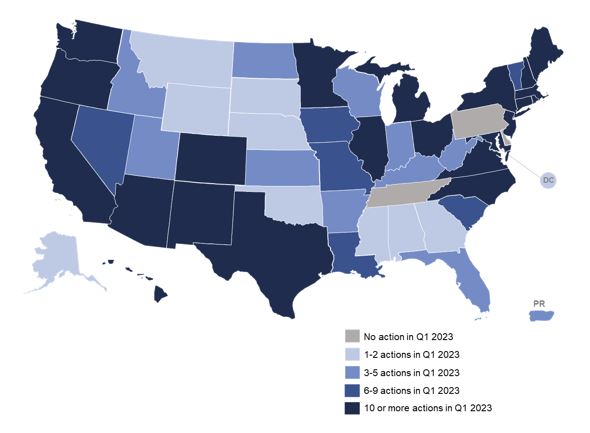The 50 States of Grid Modernization Q1 2023: States Address Microgrids, Resilience, and Low-Income Rate Reforms during Q1 2023
Raleigh, NC – (April 27, 2023) The N.C. Clean Energy Technology Center (NCCETC) released its Q1 2023 edition of The 50 States of Grid Modernization. The quarterly series provides insights on state regulatory and legislative discussions and actions on grid modernization, utility business model and rate reforms, energy storage, microgrids, and demand response.
The report finds that 47 states, as well as the District of Columbia and Puerto Rico, took actions related to grid modernization during Q1 2023 (see figure below), with the greatest number of actions relating to energy storage deployment (49), utility business model reforms (42), distribution system planning (32), interconnection rules (29), integrated resource planning (25), smart grid deployment (22), and wholesale market rules (22).
A total of 540 grid modernization actions were taken during Q1 2023. California, Texas, New York, Minnesota, Connecticut, and Maine took the greatest number of actions during the quarter, followed by Massachusetts, New Jersey, New Mexico, and Hawaii.
Q1 2023 Legislative and Regulatory Action on Grid Modernization

The report discusses three trends in grid modernization actions taken in Q1 2023: (1) states considering options to promote microgrid development; (2) states and utilities examining low-income customer-specific rate reforms; and (3) states studying and planning for electric grid resilience.
“Policy action taken in several states, including Massachusetts, Nevada, New Jersey, and New York, shows a legislative interest in microgrids, specifically their potential for improving grid resiliency,” observed Emily Apadula, Policy Analyst at NCCETC.
The report notes the top five policy developments of Q1 2023 were:
- Illinois utilities filing their first integrated grid plans;
- Texas regulators recommending the creation of a performance credit mechanism;
- Dominion Energy Virginia proposing Phase 3 Electric Grid Transformation projects;
- AEP Ohio filing its Electric Security Plan; and
- California regulators proposing ten updated rate design principles.
“This quarter, several states looked into ways for low-income ratepayers to afford their bill payments, noted Justin Lindemann, Policy Analyst at NCCETC. “Maine and New Mexico introduced legislation that focuses on setting affordable rates for low-income customers; while regulatory bodies in Connecticut and Virginia have matters open considering income and equity-focused rate making. California investor-owned utilities went a step further and introduced proposals for income-graduated fixed charge proposals that, if approved, would institute different fixed rates depending on a customer’s income bracket.”
“There were also several resiliency-based incentive programs introduced via legislation, as states like Georgia, Texas, Washington, and others, look to include energy storage and/or microgrids as eligible resiliency improvements under varying loan and grant programs — including C-PACE,” added Lindemann.
View the 50 States of Grid Modernization 2023 Q1 Quarterly Report Executive Summary
View and Purchase the 50 States of Grid Modernization 2023 Q1 Update FULL Report
View other 50 States Reports – Solar, Grid Modernization and Electric Vehicles
ABOUT THE N.C. CLEAN ENERGY TECHNOLOGY CENTER
The N.C. Clean Energy Technology Center, as part of the College of Engineering at North Carolina State University, advances a sustainable energy economy by educating, demonstrating and providing support for clean energy technologies, practices and policies. It serves as a resource for innovative, sustainable energy technologies through technology demonstration, technical assistance, outreach and training. For more information about the Center, visit: http://www.nccleantech.
Media Contact, Shannon Helm, NCCETC, shannon_helm@ncsu.edu